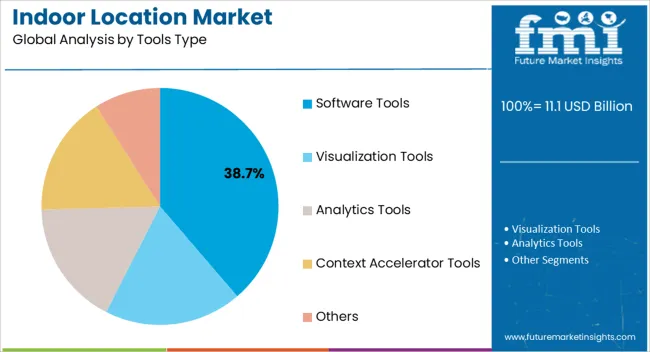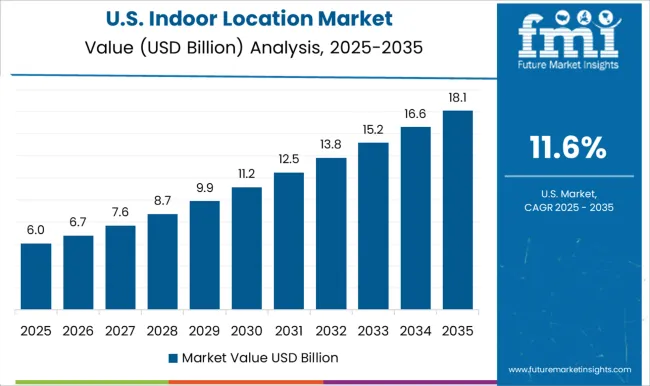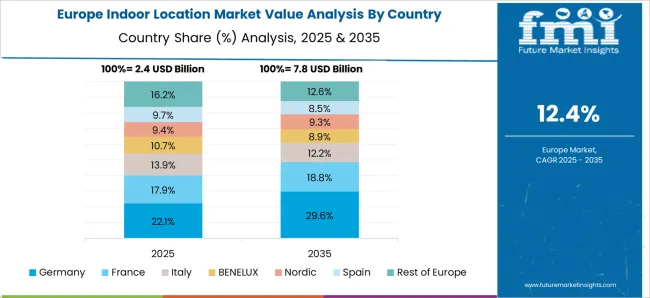The Indoor Location Market is estimated to be valued at USD 11.1 billion in 2025 and is projected to reach USD 40.1 billion by 2035, registering a compound annual growth rate (CAGR) of 13.7% over the forecast period.

| Metric | Value |
|---|---|
| Indoor Location Market Estimated Value in (2025 E) | USD 11.1 billion |
| Indoor Location Market Forecast Value in (2035 F) | USD 40.1 billion |
| Forecast CAGR (2025 to 2035) | 13.7% |
The indoor location market is experiencing rapid expansion, driven by the rising demand for real-time positioning solutions across commercial, industrial, and public infrastructure environments. Industry announcements and company reports have emphasized that retailers, healthcare providers, logistics operators, and smart building developers are increasingly adopting indoor location technologies to improve operational efficiency, customer engagement, and safety.
Technological progress in sensors, wireless communication protocols, and integration with IoT ecosystems has improved accuracy and scalability, making indoor location services more reliable for critical applications. Investments in 5G networks, cloud-based analytics, and AI-powered platforms are accelerating deployment by reducing latency and enabling advanced data-driven insights.
Moreover, government initiatives to enhance public safety and emergency response systems are supporting broader adoption. Future growth will be propelled by managed services delivering tailored solutions, RF-based technologies offering high precision at scale, and software tools providing actionable analytics for decision-making across industries.

The Managed segment is projected to contribute 44.60% of the indoor location market revenue in 2025, maintaining its leadership in service adoption. This dominance has been shaped by enterprises seeking end-to-end solutions that combine hardware, software, and ongoing support.
Managed services have been widely adopted due to their ability to reduce the complexity of deploying indoor positioning systems, ensuring seamless integration with existing IT and operational infrastructures. Reports from technology providers have highlighted that managed services deliver continuous monitoring, performance optimization, and compliance with data security standards, which are essential for enterprises handling sensitive information.
Additionally, cost predictability through subscription-based models has enhanced market penetration. With organizations prioritizing agility and scalability in digital transformation strategies, managed services are expected to remain the preferred choice for implementing and maintaining indoor location solutions.

The RF-Based segment is projected to account for 51.30% of the indoor location market revenue in 2025, establishing itself as the dominant technology category. This growth has been driven by the widespread deployment of radio frequency technologies such as Wi-Fi, Bluetooth, and RFID, which provide accurate positioning at relatively low cost.
Industry case studies have shown that RF-based systems are highly adaptable across diverse environments, from retail spaces to large industrial facilities, due to their reliability and scalability. Furthermore, the compatibility of RF-based technologies with consumer devices has facilitated broad user adoption without requiring specialized equipment.
Continuous advancements in RF chipsets and antenna designs have improved precision while reducing power consumption, further reinforcing adoption. With ongoing 5G rollouts and integration into IoT ecosystems, RF-based positioning technologies are expected to sustain their leadership in indoor location applications.

The Software Tools segment is projected to hold 38.70% of the indoor location market revenue in 2025, positioning it as the leading tools category. Growth of this segment has been supported by the critical role software plays in processing location data, generating analytics, and enabling actionable insights for decision-making.
Enterprises have adopted software tools for real-time tracking, asset monitoring, and customer behavior analysis, which drive operational efficiency and business intelligence. Reports from technology vendors have emphasized the scalability of software platforms that integrate with cloud and AI technologies, allowing businesses to deploy advanced features such as predictive analytics and automated responses.
Additionally, software tools offer flexible deployment models, from on-premise solutions to SaaS platforms, making them accessible to organizations of varying sizes. As industries increasingly focus on data-driven strategies, the Software Tools segment is expected to remain central to indoor location market growth by enabling intelligent insights and seamless integration with enterprise systems.
The global demand for indoor locations is projected to increase at a CAGR of 14.4% during the forecast period, reaching a total of USD 32,708.0 million in 2035, according to a report from Future Market Insights (FMI). From 2020 to 2025, the market recorded a significant growth of 12.3%.
The use of indoor navigation is becoming prominent across various end-user industries. The need for tracing objects, humans, and pathways has become evident. In addition, the use of IoT devices is expected to bolster the growth of indoor location systems in the upcoming years.
Furthermore, indoor location technology has helped retailers enhance their user experiences and provide proper navigation for objects or any locations. Indoor location solutions allow organizations to connect customers inside large indoor spaces with their brands, products, and partners, providing them with different ways to increase customer relationships and sales.
The proliferation of various technologies, such as BLE and Wi-Fi, enables users to detect a person’s location within a specific range.
Usage of Smartphones and IoT Devices Bolstering the Use of Indoor Location Systems
The key factors driving the growth of the indoor location market are consistent support to governments for confirming public safety, increased usage of smartphones, and inadequacy of GPS technology in indoor locations. Moreover, the rising use of smartphones with innovative mobile applications, mobile commerce, the trend of digitalization, and technological advancements are boosting the growth of the indoor location market.
Government investment has improved positioning technology for the urban security segment, and public safety is enhancing the demand for indoor location solutions in the market.
Stringent Rules Regarding Privacy and Data Collection Restraining Market Growth
Stringent rules and regulations pose one of the crucial challenges to the growth of the indoor location market. Government rules and regulations, such as the World Wide Web Consortium (W3C), Open Geospatial Consortium, and Health Insurance Portability and Accountability Act (HIPAA), restrict the data collection, sharing, and use of location-based information.
Countries across the globe prioritize the security and privacy of their citizens, which leads to the implementation of regulations that restrict the use of location-based information. Thus, these factors are restraining the growth of the indoor location market.
Global Market Share in 2025
| Countries | CAGR |
|---|---|
| United States | 19.4% |
| Germany | 10.4% |
| Japan | 2.4% |
| Australia | 1.7% |

Increasing Use of Proximity-based Solutions in the Retail Sector Bolstering Growth
North America is experiencing a rapid increase in the adoption of indoor locations as the demand for customized indoor location solutions, owing to the increasing use of proximity-based solutions in the retail sector, is rising at a faster pace.
The North American region continues to account for a significant share of the overall indoor location market due to the usage of mobile media by enterprises for promoting services and products and the increasing adoption of location-enabled searches by individual users. North America possesses a 27.6% market share for the indoor location market through 2035.

Development of Commercial and Residential Sectors Propelling the Growth
The indoor location market for Europe is also expected to witness steady growth during the forecast period, primarily attributed to the growth of indoor location technologies coupled with demand for customization in offerings, especially in Germany and Italy.
In addition, the rapid development of commercial and residential sectors is positively influencing the use of indoor locations. Thus, Europe held a 23.7% market share for the indoor location market in 2025.
Shifting Technological Developments Positively Influencing Market Growth
Professional services are crucial and comprise solutions offered by the service providers to increase the awareness and growth of indoor location solutions and technology for attracting customers to stores and navigation.
In terms of the indoor location services segment, this segment accounts for a high adoption rate in the overall indoor location market owing to its requirement to flow with shifting technology that can be used for advanced development in the market. Thus, by service type, professional services are expected to hold 34.6% of the market share for the indoor location market.
Asset Tracking in RF-based Indoor Locations to Guide Indoor Location Market's Growth
RF-based indoor locations utilize the wireless signals emitted by Wi-Fi access points, Bluetooth beacons, and other RF sources to triangulate positions. RF-based indoor locations find applications in wayfinding and navigation, asset tracking, and retail analytics.
RF-based systems guide users to track the movement of assets and inventory in spaces like warehouses and storage facilities.
RF-based systems and other technologies offer advanced accuracy and coverage, such as sensor fusion and dead reckoning. Therefore, RF-based indoor location systems are anticipated to dominate revenue in the forecast period, holding a share of 42.3% through 2035.
Key players in the indoor location market are SIRL, IIWARI, Arara, Invento Robotics, and ARWAY.

Key players in the indoor location market are Apple Inc., Broadcom Corporation, CISCO Systems Inc., Ericsson, Google Inc., Microsoft Corporation, Motorola Solutions, Nokia Corporation, STMicroelectronics N.V., Qualcomm, and Others.
Recent Developments
| Report Attribute | Details |
|---|---|
| Market Value in 2025 | USD 11.1 billion |
| Market Value in 2035 | USD 40.1 billion |
| Growth Rate | CAGR of 13.7% from 2025 to 2035 |
| Base Year for Estimation | 2025 |
| Historical Data | 2020 to 2025 |
| Forecast Period | 2025 to 2035 |
| Quantitative Units | Revenue in USD million and CAGR from 2025 to 2035 |
| Report Coverage | Revenue Forecast, Volume Forecast, Company Ranking, Competitive Landscape, Growth Factors, Trends and Pricing Analysis |
| Segments Covered | Service, Technology, Software Tools, End Use, Application, Region |
| Regions Covered | North America; Latin America; Western Europe; Eastern Europe; Asia Pacific Excluding Japan; Japan; The Middle East and Africa |
| Key Countries Profiled | United States, Canada, Brazil, Argentina, Germany, United Kingdom, France, Spain, Italy, Nordics, BENELUX, Australia & New Zealand, China, India, ASEAN, GCC, South Africa |
| Key Companies Profiled | Apple Inc.; Broadcom Corporation; CISCO Systems Inc.; Ericsson; Google Inc.; Microsoft Corporation; Motorola Solutions; Nokia Corporation; STMicroelectronics N.V.; Qualcomm; Zebra Technologies |
| Customization | Available Upon Request |
The global indoor location market is estimated to be valued at USD 11.1 billion in 2025.
The market size for the indoor location market is projected to reach USD 40.1 billion by 2035.
The indoor location market is expected to grow at a 13.7% CAGR between 2025 and 2035.
The key product types in indoor location market are managed and professional.
In terms of technology type, rf-based segment to command 51.3% share in the indoor location market in 2025.






Full Research Suite comprises of:
Market outlook & trends analysis
Interviews & case studies
Strategic recommendations
Vendor profiles & capabilities analysis
5-year forecasts
8 regions and 60+ country-level data splits
Market segment data splits
12 months of continuous data updates
DELIVERED AS:
PDF EXCEL ONLINE
Indoor Rotary High Voltage Disconnect Switch Market Size and Share Forecast Outlook 2025 to 2035
Indoor Cable Assemblies Market Size and Share Forecast Outlook 2025 to 2035
Indoor Residential Switchgear Market Size and Share Forecast Outlook 2025 to 2035
Indoor Air Quality Monitor Market Size and Share Forecast Outlook 2025 to 2035
Indoor Space Heater Market Size and Share Forecast Outlook 2025 to 2035
Indoor Farming Market Analysis - Size, Share, and Forecast 2025 to 2035
Indoor Smokehouses & Pig Roasters Market – Smoked Meat Processing 2025 to 2035
A Detailed Global Analysis of Brand Share for the Indoor Farming Market
Smart Indoor Gardening System Market Size and Share Forecast Outlook 2025 to 2035
Family/Indoor Entertainment Centres Market Report – Forecast 2017-2027
Cat Condos & Indoor Houses Market Insights - Size & Trends 2025 to 2035
Location Analytics Market Size and Share Forecast Outlook 2025 to 2035
Location Intelligence Market Size and Share Forecast Outlook 2025 to 2035
Location-Based Marketing Services Market Trends - Growth & Forecast through 2035
Colocation Edge Data Center Market Size and Share Forecast Outlook 2025 to 2035
Tip Location Device Market Analysis – Size, Share, and Forecast Outlook 2025 to 2035
Micro-location Technology Market Size and Share Forecast Outlook 2025 to 2035
Retail Colocation Market Size and Share Forecast Outlook 2025 to 2035
Real Time Location System (RTLS) Market Size and Share Forecast Outlook 2025 to 2035
Hazardous Location Limit Switches Market

Thank you!
You will receive an email from our Business Development Manager. Please be sure to check your SPAM/JUNK folder too.
Chat With
MaRIA